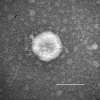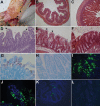Pathogenicity of 2 porcine deltacoronavirus strains in gnotobiotic pigs
- PMID: 25811229
- PMCID: PMC4378491
- DOI: 10.3201/eid2104.141859
Pathogenicity of 2 porcine deltacoronavirus strains in gnotobiotic pigs
Abstract
To verify whether porcine deltacoronavirus infection induces disease, we inoculated gnotobiotic pigs with 2 virus strains (OH-FD22 and OH-FD100) identified by 2 specific reverse transcription PCRs. At 21-120 h postinoculation, pigs exhibited severe diarrhea, vomiting, fecal shedding of virus, and severe atrophic enteritis. These findings confirm that these 2 strains are enteropathogenic in pigs.
Keywords: PCR; PDCoV; coronavirus; gnotobiotic pigs; pathogenicity; pigs; porcine deltacoronavirus; strain OH-FD100; strain OH-FD22; strains; viruses.
Figures


References
-
- Cima G. Viral disease affects U.S. pigs: porcine epidemic diarrhea found in at least 11 states. J Am Vet Med Assoc. 2013;243:30–1 . - PubMed
Publication types
MeSH terms
Substances
LinkOut - more resources
Full Text Sources
Other Literature Sources

